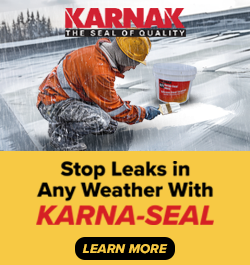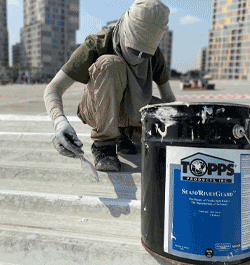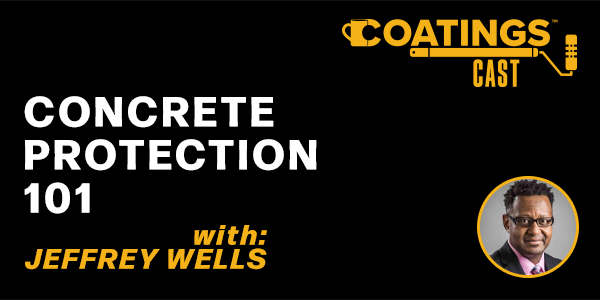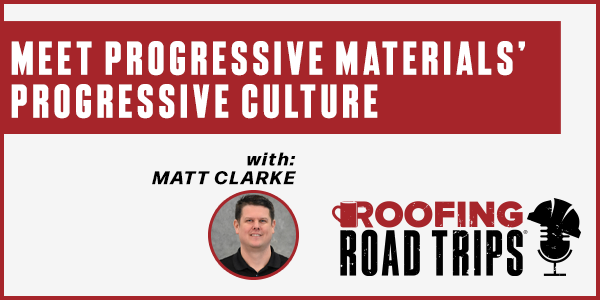UP TO THE MINUTE
Jeffrey Wells - Concrete Protection 101 - PODCAST TRANSCRIPT
June 12, 2024 at 12:00 p.m.Editor's note: The following is the transcript of a live interview with Jeffrey Wells of APF Polymer Surfaces. You can read the interview below or listen to the podcast.
Intro: Welcome to CoatingsCast, the ultimate podcast dedicated to the science, art and innovation of liquid and fluid applied roofing, coatings for surfaces and waterproofing. It's time to roll up our sleeves, put on our lab coats and dive headfirst into the world of liquid protection that keeps your roofs and surfaces in prime condition. The future is here, and it's liquid, so don't miss out. This is CoatingsCast, where every drop counts in the world of roof and surface protection.
Karen Edwards: Hello, everyone, and welcome to this episode of CoatingsCast. I'm your host. My name's Karen Edwards, and I am so excited about this topic today, because this is brand new for me. We are going to be talking with Jeffrey Wells from APF Polymer Surfaces to just talk all about concrete flooring applications. We think, in this industry, a lot of times, we're thinking of coatings and liquid applied systems is really being on roofs, but there's so many more applications for it and concrete being one of them. So, Jeffrey, welcome. It is great to have you here. Could you just say hello and introduce yourself?
Jeffrey Wells: Absolutely. Hello, everybody. I am Jeff Wells. I am director of sales for ICP, the APF Polymer Surfaces Group. I've come from the industry for about 30 years through various companies prior to this one, and I have been a speaker and trainer in the industry of the concrete and decorative concrete worlds. I managed the division now that handles products from food and beverage to government to commercial and residential, and I'm really excited to talk about this entire market of this concrete world.
Karen Edwards: Yeah, I'm excited to learn about it. So, before we dive in, tell me what does APF Polymer Surfaces do? What do you guys make?
Jeffrey Wells: Yes. Well, we make an array of coatings, everything from epoxy to polyurethane to moisture mitigation products as well as urethane mortars and cements and sealers. Just pretty much anything that provides a solution to some of the challenges that are known with concrete today. But also, we provide some unique looks that make concrete a little bit more pretty and a lot more palatable to the eye.
Karen Edwards: Okay. So let's talk a little bit about the different purposes for concrete flooring. What kind of a business or application might want a concrete floor?
Jeffrey Wells: Absolutely. Well, the one thing that you will always know is that concrete is everywhere. It's the largest construction product and manufacturing. In fact, what's interesting about your specific prowess there, Karen, is that it's the footprint of the roof, so you can't have a roof without having a concrete substrate in most cases first. So in that building envelope package, we address things like, number one, safety. How do we make a concrete pallet more safe? How do we make it look better? How do we make it last longer?
Jeffrey Wells: We've got the inherent issues such as water, moisture, salt, chemicals, just all kinds of thing, movement, even if you will in some of the southern areas. So one of the things that we like to do is to help individuals understand not just the products that we would offer at APS, but also understand how does the concrete relate to the product. So you want to plan the concrete. A lot of the times, people go in, they plan the system or they plan the outcome, but the first place you have to start is really planning your concrete. And for example, some of the areas and markets, so there's airplane hangars, there's food and beverage, there's homes, there are commercial facilities, warehouses, hospitality, all these different areas require so many different looks, so many different outcomes yet all designed to be covered by some type of system.
Karen Edwards: Wow. Yeah, that's crazy. And the challenge is I only know I had a duplex at one time, and it was on a slab, right? There was no basement. And when I wanted to put a flooring down, I had to put a piece of plastic, I guess, because concrete was going to absorb or have moisture. It's porous, I guess, right? So all those applications, in the case of maybe an airplane hangar, which you mentioned it doesn't really need to look pretty, right? But it needs to stay intact. So what would some of those challenges be and how would you know what's the best product put down, because airplanes are heavy, right? That's a lot of-
Jeffrey Wells: They're heavy.
Karen Edwards: The weight-
Jeffrey Wells: And something that is probably more adjacent to need is also going to be that the chemicals needed to maintenance an aircraft are going to be some of your most caustic chemicals. So you're going to need a lot of protection. And generally speaking, if you do have an airplane, especially if you're a private owner of an airplane, you probably want that hangar to look somewhat kind of pretty. If you're doing commercial aircraft and you want it to be durable, so a couple of things that we look at is what does the chemical resistance component comprise of? Is it a novolac type of application? Is it a urethane mortar cement type of application, or are we trying to just do maintenance? Do we just don't do a lot? And we talk about, say, the aircraft is heavy. Well, it's amazing that there's things in that environment that actually attack the floor more in the plane. The plane's usually going in, and it's going out.
Karen Edwards: Right.
Jeffrey Wells: There's a lot of times there's machines and equipment, all those things that service that plane, they actually do more structural damage and impact to that floor than what the plane will ever do. So a combination of that is understanding everything that doesn't always, as they say, is not always used the way that it was intended. An example of that is the residential garage. Residential garages now have become... 38% of them are additional living spaces, so that totally changes. Another 20% are storage. So basically half of people are actually parking in their garages.
Jeffrey Wells: So at the end of the day, you kind of have to look at what's the ultimate outcome? What are you trying to accomplish? And then, that airplane hangar, the other part of that is you might even be working with things that are maybe flammable. So you might need a spark proof type of floor application. So we like to take the look of the purpose, look at outcome and then what the expectation of the life cycle is going to be. Those are the three things that we usually kind of land on, determine what system we would put in any kind of environment.
Karen Edwards: And it's really interesting how similar that is to roofing, right? Because they're looking at how's the building being used? Is it a food manufacturing facility? Are there going to be greases exhausting through the top? So we're just turning that upside down and starting with that same scenario but from the bottom up, right?
Jeffrey Wells: Yes, the same thing. I mean, when you start looking at, say, for example, our APS jet deck system, the 200 or the 300, people say, "Okay, well, what's the difference? When they're going to read it, they're going to look at the product seem very, very similar, but the construction of that system is really uniquely different." One's going to offer a much higher type of chemical resistance, and you might be changing the look a little bit. Whereas maybe you're not going to be flying as often or you don't take your aircraft out as often, then you might use a system that gives you better cost-effective performance over time. So it's much like a roof, and everybody's always budget conscious, but as you well know with roofing and flooring, there's just some things you just can't sacrifice for price.
Karen Edwards: So true, so true. So I want to understand what... We're calling it a system, right? We're not just pouring concrete and putting a seal over it, right?
Jeffrey Wells: That's [inaudible 00:08:28].
Karen Edwards: What does a system look like? Kind of help me understand the layers and what each of them does.
Jeffrey Wells: All right, so let me walk you through it. So let's take it from the standpoint of the concrete. The assumption is that concrete's concrete, but there is new concrete. There's bare concrete. There's previously painted and/or sealed concrete. There's densified concrete that's used with the sodium silicate, so I do what's called CSI. Now, there is a CSI organization, but in the action of evaluating concrete, I kind of call it concrete scene investigation. I try to take a read what's going on? Where's the chalk lines at? And in our world, chalk lines are cracks. And then, there's gouges. And then, there's sometimes people, you know what they do, they change their minds about an installation or an application or... For example, they decide to move a drain. Well, you have to take that concrete out, and you have to put new concrete back in. That's not the same concrete, and that substrate's going to look a lot different fixing that one area than it did when you did the entire installation.
Jeffrey Wells: Last but not least, I'm going to be looking for moisture. It is the best friend of concrete when it's cast in place, because the hydration obviously helps the concrete get strong. However, it's his worst enemy once you actually put the concrete in place. So I'm going to be looking for how well it's cured. I'm going to be looking for how dense it is. And then, when I get those things together, now I've got my pallet, so the first thing I'm going to do is put in something to chase the cracks if I have those or if I have to use a patching material.
Jeffrey Wells: Then, the next product I'm going to build out is some type of primer coat, something that basically gives me a much cleaner application to my system. Then, a lot of systems after the primer require a base coat. This is kind of going to be, if you will, the beginning of the outcome. The primer is there. And a lot of times, that primer, if there's a moisture situation, you use a moisture mitigation primer. But if not, then a standard primer for an epoxy primer would certainly work.
Jeffrey Wells: But once you get that layer in, now you start building out your outcome. So you're going to have kind of a base code if you're doing a metallic finish, it might be a black epoxy or some type of colored epoxy that's designed to receive maybe a flake or maybe a quartz, something that you're going to do that's going to be on the decorative end. And then, at other times, they build what's called a mortar coat. A mortar coat is when you're going to build a more advanced system for a harder chemical resistance and durability. You might mix that with sand, and then you'll put another coat on top of it to kind of sandwich it in.
Jeffrey Wells: And then, you'll put kind of your outcome coat. I always call that. What am I going to see? Typically, what's interesting is we never see the system. You only see the result, because the thing you're standing on is the finish. So I'm either looking at... So if my epoxy's going to be a red epoxy, I still got to come back over it with a polyurethane or a polyurea or polyaspartic, some type of product that's going to yield that final contact to either the tire, the chair, the foot or whatever the environment's use is going to be. So some systems are two to three layers deep. Others can be five, six, just depending on first of all obviously, what is the environment, what's its use and what's it going to need.
Karen Edwards: Okay, so this is really interesting, because there are so many uses and so many... If we talk about, do you guys have a niche? Do you really focus on industrial applications or production facilities or you cover it all, maybe?
Jeffrey Wells: I would say yes, Karen. That is what we do. In fact, we even try to create some different markets, but let's just say an area focus, our industrial strengthened market is extremely high. We are a very high specified product system, coating system. We are also very well known throughout the United States as being a go-to company for this space, and there's really not a space that we don't play. We even have special products that are only used by even the government in some instances for space in aeronautics. They require much more stringent types of qualifications to utilize those products. So we have unique technology such as our ESD Nano type of product. It's really unique in the world of trying to keep a spark from occurring on the substrates. We can handle any typical epoxy or polyurethane or urethane mortar insulation, but yes, we do have some things that are unique. So what we do is we do everything that a coating or a sealer can be put on.
Karen Edwards: Okay. Okay. Fair enough. I want to talk a little bit about aesthetics, because there are some pretty incredible things that you can do with finishes on concrete now that maybe look like wood or look like stones or talk a little bit about the plethora of options for finishes.
Jeffrey Wells: Yes, absolutely. A lot of times, that's what's great is that we start with the base of design is typically color. Someone's going to a color chart or taking a color card and picking a color. But to your point, what's really happening now are effects, is creating something. So we actually do have overlay products that can be used to design and sculptured into stone or natural terrazzo looks or we can even to your point even do wood and we can create some very unique finishes. We even have what we call our chrome system that produces a metallic, almost kind of like a car-like finish on the floor and it's done by using epoxies and letting the epoxies flow and manipulating them to achieve different color designs.
Jeffrey Wells: Obviously, probably very heavy in the industrial and commercial space or we call our Granitex flooring system. These are where we use flake chips to rejection, and they are creating multicolored, highly visible. And also, too, because of the flake, they create very safe substrates as well, because they create a profile that adds to the slip resistance value of the floor. And we also accomplish this in our court system as well. You can get almost kind of a fine glass-like look to it, and a lot of people actually like that as well. A number of kind of traditional looks such as acid stain or water-based stain can also be applied. And what we typically kind of like to do is figure out what your outcome is relative to all the other design, things you have in that space. And then, a lot of times, that's where you're going to get your inspiration or you're going to get your focus for your final outcome.
Karen Edwards: Okay. So I am curious to know how difficult is it? Because I've seen photos of some of these finishes, and they're just beautiful. And if I'm the installer, I'm almost needing to be an artist, right or very skilled craftsman. What's that learning curve like to be able to get that?
Jeffrey Wells: That's a great question, and we do have a lot of people that can go online. And typically, feel that if they've watched a few videos, that they are risen experts. But I'm here to tell you that some of these finishes, Karen, really require, to your point, it is the sophistication of a skilled craftsman for any type of endeavor, but it also involves kind of some experience. Most things go well when you're in the middle of the floor. A lot of things don't go so well when you're against the wall, and you're coming off of a natural edge that stops immediately, such as a transition area that you're not going to be in. All those areas tend to take a little bit more finesse. But when you talk about, let's just say what is maybe novice, what is maybe that medium skill level versus a high skill level. A grind and seal floor, that's probably a novice type of application where you come in, prepare the concrete, then you would put a stain or an application of color over that and then put a couple of coats of a single component clear coat over that.
Jeffrey Wells: A lot of people have been doing pretty well at, say, a well-managed space, like a residential garage, something that's maybe 500 square feet or less, where they come in, do the correct prep. Usually, it's always mechanical and not just chemical. And then they put down, say, a primer coat of epoxy, then come back with that base coat that we talked about earlier and either flake it or broadcast something in it and put on a clear coat. Those are the things that if you're going to say moving from do it yourself to maybe even more DIFM, do it for me, types of applications where someone would kind of assist you or help you. But when you get into your more to your urethanes and you get into your chemical-resistant epoxies, it's always good to make sure that you have a well-established professional contractor to review those applications, because you can get started and go well, but most of the time, people are not happy with the final outcome if they hadn't really been doing that for a while.
Karen Edwards: Right. Yeah, practice makes perfect in that case.
Jeffrey Wells: Exactly. Absolutely. Always do a mock-up. So that's a great point. No matter what you decide to do, whether someone does it for you or you do it yourself, always get you a board or something or Masonite board or something and do your little practice.
Karen Edwards: Yeah, that's a great idea. I have a question, too, because I'm curious about safety in terms of application. What are some safety considerations that contractors should be considering depending on the different type of system that they're installing?
Jeffrey Wells: Yeah, so my first thing is that a lot of products, whether you read them or not, you always want to assume some flammability responsibility there. So always make sure you're not working near a pilot light or some type of open flame or any place where there could be an exposure to some type of fire. The other thing I always recommend is proper ventilation is to make sure that wherever you're at, there's a great air supply. A lot of products now are VOC-compliant. They're volatile organic compounds, are really helping us to stay a lot safer, but at the end of the day, you don't want to take your health or risk for granted, so you always want to make sure you're properly ventilated.
Jeffrey Wells: I think last but not least is proper PPE.
Karen Edwards: Yes.
Jeffrey Wells: Just to make sure though, that you have on your mask, you have on goggles, you're wearing gloves, you have a long sleeves, you have steel-toe boots or things that at least work to protect you. I would always recommend that in certain situations you're not looking up, so you might even have a hard hat or something like that as well. But what you're really wanting to do is to make sure that from a project perspective, you get the best out of it and that anybody who goes to do a project, either they get to enjoy it or that the people who do it get back the way that they came. So those would be the things I'd recommend.
Karen Edwards: Excellent. Yeah, we didn't have that on our list of questions, but I always am thinking in terms of safety-
Jeffrey Wells: Always, yes.
Karen Edwards: ... any type of trade or work. Yeah, definitely.
Jeffrey Wells: And the other part of that, too, is you'd be surprised, Karen and maybe this may or may not be a shocker to you, but how many people who don't read the directions right.
Karen Edwards: Yeah, right.
Jeffrey Wells: Safety data pages or the technical data pages, there's a lot in there. I don't care where your point of purchase is going to be. No one can educate you better than you educating yourself. So even with the video, they're not typically going to read that product data page or the directions, but that's where the safety therein lies. Companies do a great job these days of putting in fail-safes, but we do a great job of just going right past the fail-safe as consumers. So that would be a strong recommendation I would have is if the job's going to be worth an hour doing, then they spend at least 10 minutes reading.
Karen Edwards: Right, right. Yeah. I mean those safety data sheets, the technical data sheets, they exist for a reason, right?
Jeffrey Wells: They do-
Karen Edwards: Proper handling.
Jeffrey Wells: ... keep you safe. Exactly.
Karen Edwards: Proper storage, proper, yeah, safety.
Jeffrey Wells: When they even give you things, if something does go wrong, I mean, we all know it's kind of like you always know what to do until something really goes wrong. Somebody were to ask you, but when it happens in real time and the other thing, too, is I would be remiss is that when you're working with flooring materials and I'm sure it's the same with roofing, try to distract yourself from your cell phone, put it away, put it somewhere where you're focused on getting the job finished and then take that call or return that text message, because I've worked with a number of organizations and even on a couple of industry organizations where we talk about our safety moments and things that have happened and typically fatigue, distraction and unawareness create a lot of unsafe zones where during these applications. So that'd be something I would recommend.
Karen Edwards: That's so true. So true. It's easy. Just like driving, put your cell phone down. If you're focusing on the job and working, you don't need it. It can wait.
Jeffrey Wells: Absolutely. It can wait.
Karen Edwards: Excellent. Well, Jeffrey, you have certainly been a wealth of knowledge. I've learned so much today, but I would like to share if someone listening to this, wants to find your products and maybe get started in concrete coatings and in this kind of work, what's your advice?
Jeffrey Wells: My first advice is to really consider why you're getting in it. I mean, is there a need? Are you expanding out, because you got to have the passion for it. I mean, typically people who have started, they viewed it as like painting. And I come from a paint background as well, painting and flooring. While you may have words and nomenclature that seems very similar, doing a wall is a lot different from doing a floor. And most of the time, a wall doesn't shut a project down, but a floor can.
Jeffrey Wells: So my thing is always make sure that you're willing to invest in the surface preparation. That means the tooling, the training, the education, be a scholar of your concrete, know what you have, because that is going to be typically the one thing that you're going to have to face almost alone in your bidding and you're creating out who you're going to utilize, what system you're going to be working with. If you don't get a good concrete read, you're almost certainly to be applying a failure. And so obviously, those are things you'd want to avoid.
Jeffrey Wells: If a person did want to get involved. We, ourselves and our Phoenix location with Arizona Polymer Surfaces, is that we offer training to get some hands-on. I mean, a lot of times, one thing I always said is that anybody could go get a roller cover, a roller tray, an extension pole and some... And just start painting a wall. But with flooring, make sure to take advantage of whatever training that's being offered. You want to make sure that before you get on a live job site, that you've got a chance to get in the bag, get in the bucket and that you're going to know what you're going to get from the system that you're going to be putting down.
Jeffrey Wells: And a lot of times, we get excited. We want to get into it. The other thing, too, is I would consider is market demand. Finding something that makes a niche for you. Be good at moisture mitigation or really be good at electrostatic installations or maybe urethane mortar cements or even decorative. Find something, because right now, there's a lot of people that are doing this. There's a pretty crowded dance floor, but at the end of the day, there's always room to play. But where I've seen a lot more success also, too, is that the more you become good at something, the more you become known as being good at that particular thing.
Karen Edwards: Right.
Jeffrey Wells: So that can cover a lot of the nuance of getting started and up and running, can always bolt-on, but really be good at that one thing first.
Karen Edwards: Yeah, referrals and word of mouth, it starts to get around that this person-
Jeffrey Wells: Absolutely.
Karen Edwards: ... really knows what they're doing. Yeah.
Jeffrey Wells: Yeah, absolutely. And once, there's nothing wrong with reaching out to someone and sharing that experience with them, having them on your job site. And then, obviously you always want to put in video, even your learning curves, because those are great things that you can help future consumers or customers learn what you're not going to do and take those learnings. And a lot of times, you'd be surprised how many people, they don't want to just know how good you are. They want to also know the things you're going to be avoiding. And that also wins a lot of opportunities.
Karen Edwards: Excellent. Good advice. Thank you, Jeffrey. It was a pleasure to have you here today. If you want to know more information, go to coatingscoffeeshop.com because APF has a full directory on there with contact information, product information and how to get in touch with them. So I want to just thank everyone for listening today and be sure to follow us on social media, tune in on your favorite podcast platforms, so you can listen to future episodes, where we will be talking about all things liquid applied on the roof and on the ground and maybe even below grade. So thanks for tuning in, everybody. We'll see you next time. Thank you, Jeffrey.
Jeffrey Wells: Thank you, Karen. See you.
Outro: Thanks for joining us on this coating adventure. Stay tuned for more episodes. And in the meantime, be sure to follow us on social media to stay updated with all things, roof coatings. Until next time, stay coated. For more information, go to coatingscoffeeshop.com.
About Hannah
Hannah Ford is a content intern for the Coffee Shops. She is a student at Oregon State University pursuing her bachelor of science in marketing. In her free time she enjoys reading, art, music and trying new restaurants.



















Comments
Leave a Reply
Have an account? Login to leave a comment!
Sign In